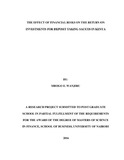| dc.contributor.author | Mbogo, Wanjiru E | |
| dc.date.accessioned | 2017-01-06T12:10:55Z | |
| dc.date.available | 2017-01-06T12:10:55Z | |
| dc.date.issued | 2016 | |
| dc.identifier.uri | http://hdl.handle.net/11295/99677 | |
| dc.description.abstract | The Sacco Societies Regulatory Authority (SASRA) which is a statutory state corporation
established under the Sacco Societies Act (Cap 490B) of the Kenyan law was set up and
the guiding Regulations 2010 became operational from June 18th in 2010. The regulatory
body from then standardized the operations by setting guidelines for operations and
regulatory requirement that the DTSs must adhere to for their licenses to operate deposittaking
services to be granted. The study focus was on the period post the regulatory body
set up because is the period the DTSs operations were in harmony by being standardized
by the guidelines and regulations put in place. Thus analysis of the financial reports was
hence possible as the DTSs were subject to the same reporting standards. The objective of
the study was to establish the effect of financial risk on the return on investment for DTSs
in Kenya. The study sought to bridge the knowledge gap that exists on the area relating to
financial risks and return on investment in Deposit Taking SACCOs since previous studies
done on DTSs had not focused this particular subject. The study reviewed the studies that
have been done on areas around and related to financial risks and return on investment
around the world. A brief history of the SACCO sector in Kenya to the emergence of DTSs
was discussed to help readers understand the background of the study. The study type
conducted was a census focusing on DTSs in Kenya based on industry statistics. Secondary
data was used for this study and data was analyzed using Statistical packages for social
sciences software- SPSS 2.0. Descriptive data analysis was conducted using linear
regression model to analyze data in this study. Financial analysis on the DTSs’
performance was carried out. The study focused on four independent variables whose effect
on the dependent variable was predicted. The dependent variable in this study was return
on investment using the measure of return on assets. The independent variables were
financial risks, capital adequacy, management efficiency and asset quality. The results of
the data analysis indicates that financial risks has significant effect on the return on
investment for DTSs. The study shows that in addition to the financial risks, other
determinants of return on investments have significant effect on return on investment
which are capital adequacy, management efficiency and asset quality. The study indicated
that the variables under study are correlated to one another. Financial risks is strongly
presented as an important factor determining the return on investments for DTSs in Kenya.
For the DTSs to achieve desired growth and maintain an increasing trend on return on
investments, management should be proactive on implementation of financial risks
management tactics and adoption of policies that strive to mitigate financial risks to be able
to maintain the risks at the minimum levels possible. The expectation is that the findings
of this research will assist in filling that knowledge gap and contribute to further research
on unexplored aspects of performance and operations of DTSs as well as related financial
institutions. The study recommends that SASRA regulatory body should intervene and set
limits for the other key financial soundness indicators beyond the capital adequacy ratios
which they have already implemented. The other key financial soundness indicators
referred to here are asset quality, earnings& profitability and liquidity. Regulatory bodies
should implement policies that safe guards use of members savings in DTSs against misuse
by the management teams. The study also authorities should set limits of the level of
investments in assets that are not explicitly classified into either financial investments orproperty plant and equipment which are blankly referred to as other assets should be, this
being measured as other assets value expressed as a percentage of total assets value. | en_US |
| dc.language.iso | en | en_US |
| dc.publisher | University of Nairobi | en_US |
| dc.rights | Attribution-NonCommercial-NoDerivs 3.0 United States | * |
| dc.rights.uri | http://creativecommons.org/licenses/by-nc-nd/3.0/us/ | * |
| dc.subject | Financial risks on the return on Investments | en_US |
| dc.title | The Effect of Financial Risks on the Return on Investments for Deposit Taking Saccos in Kenya | en_US |
| dc.type | Thesis | en_US |



